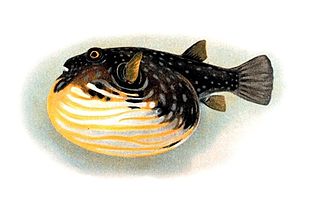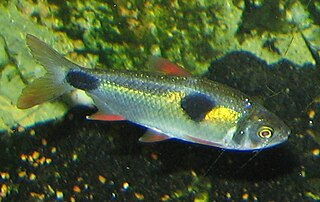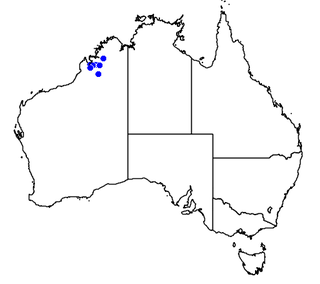
Tetraodontidae is a family of primarily marine and estuarine fish of the order Tetraodontiformes. The family includes many familiar species variously called pufferfish, puffers, balloonfish, blowfish, blowers, blowies, bubblefish, globefish, swellfish, toadfish, toadies, toadle, honey toads, sugar toads, and sea squab. They are morphologically similar to the closely related porcupinefish, which have large external spines. The scientific name refers to the four large teeth, fused into an upper and lower plate, which are used for crushing the hard shells of crustaceans and mollusks, their natural prey.

The archerfish form a monotypic family, Toxotidae, of fish known for their habit of preying on land-based insects and other small animals by shooting them down with water droplets from their specialized mouths. The family is small, consisting of ten species in a single genus, Toxotes. Most species live in fresh water rivers, streams and pools, but two or three are euryhaline, inhabiting both fresh and brackish water habitats such as estuaries and mangroves. They can be found from India, Bangladesh and Sri Lanka, through Southeast Asia, to Northern Australia and Melanesia.

A barracuda is a large, predatory, ray-finned fish known for its fearsome appearance and ferocious behaviour. The barracuda is a saltwater fish of the genus Sphyraena, the only genus in the family Sphyraenidae, which was named by Constantine Samuel Rafinesque in 1815. It is found in tropical and subtropical oceans worldwide ranging from the eastern border of the Atlantic Ocean to the Red Sea, on its western border the Caribbean Sea, and in tropical areas of the Pacific Ocean. Barracudas reside near the top of the water and near coral reefs and sea grasses. Barracudas are targeted by sport-fishing enthusiasts.

The bluegill, sometimes referred to as "bream", "brim", "sunny", or "copper nose" as is common in Texas, is a species of North American freshwater fish, native to and commonly found in streams, rivers, lakes, ponds and wetlands east of the Rocky Mountains. It is the type species of the genus Lepomis, from the family Centrarchidae in the order Perciformes.

Clarias is a genus of catfishes of the family Clariidae, the airbreathing catfishes. The name is derived from the Greek chlaros, which means lively, in reference to the ability of the fish to live for a long time out of water.

Mycteroperca microlepis, the gag, also known as gag grouper, velvet rockfish or charcoal belly, is a species of marine ray-finned fish, a grouper from the subfamily Epinephelinae which is part of the family Serranidae, which also includes the anthias and sea basses. It comes from warmer parts of the West Atlantic, including the Caribbean and Gulf of Mexico. It is a drab, mottled-gray fish lacking the distinguishing features of most other groupers. Its pattern of markings resemble the box-shaped spots of the black grouper. It lacks the streamer-points on the tail fin that scamp and yellowmouth grouper have and lacks yellow coloration around the mouth.

Lepidophagy is a specialised feeding behaviour in fish that involves eating the scales of other fish. Lepidophagy is widespread, having evolved independently in at least five freshwater families and seven marine families. A related feeding behavior among fish is pterygophagy: feeding on the fins of other fish.

Hemibagrus wyckioides, the Asian redtail catfish, is a species of catfish of the family Bagridae.

The bayad, is a species of bagrid catfish from Africa.

The big scale archerfish is a species of fish in the family Toxotidae. It is endemic to the Molucca Islands (Indonesia) and possibly the Philippines. Almost nothing is known about this species and there is only a single confirmed specimen, which likely was collected from Bacan ("Batjan") Islands. It was formerly reported from Western Australia, but this is a separate species, T. kimberleyensis.

Fish intelligence is the resultant of the process of acquiring, storing in memory, retrieving, combining, comparing, and using in new contexts information and conceptual skills" as it applies to fish.

Scyllarides latus, the Mediterranean slipper lobster, is a species of slipper lobster found in the Mediterranean Sea and in the eastern Atlantic Ocean. It is edible and highly regarded as food, but is now rare over much of its range due to overfishing. Adults may grow to 1 foot (30 cm) long, are camouflaged, and have no claws. They are nocturnal, emerging from caves and other shelters during the night to feed on molluscs. As well as being eaten by humans, S. latus is also preyed upon by a variety of bony fish. Its closest relative is S. herklotsii, which occurs off the Atlantic coast of West Africa; other species of Scyllarides occur in the western Atlantic Ocean and the Indo-Pacific. The larvae and young animals are largely unknown.

The banded archerfish is a brackish water perciform fish of the archerfish genus Toxotes. It is silvery in colour and has a dorsal fin towards the posterior end. It has distinctive, semi-triangular markings along its sides. It is best known for its ability to spit a jet of water to "shoot down" prey. Larger specimens may be able to hit prey 2 to 3 metres away. The banded archerfish may reach the displaced prey within 50 milliseconds of its hitting the water.

Toxotes chatareus, sometimes known by the common names common archerfish, seven-spot archerfish or largescale archerfish, is a species of perciform fish in the archerfish genus Toxotes.

The smallscale archerfish is a perciform fish of genus Toxotes. As its name suggests, the scales of the smallscale archerfish are smaller than those of other archerfish. They reach a maximum length of 15 centimetres (5.9 in). Smallscale archerfish live in the tropical Indo-Pacific region and are potamodromous, moving between fresh and brackish water through their lifetimes.
Protoxotes lorentzi is a tropical freshwater fish found in streams and swamps of the Northern Territory of Australia, Irian Jaya (Indonesia), and Papua New Guinea. It was first named by Weber in 1910, and is commonly known as the primitive archerfish or Lorentz's archerfish.

Toxotes kimberleyensis is a species of archerfish found in the Kimberley region of Western Australia. It was first named by Gerald R. Allen in 2004, and is commonly known as the Kimberley archerfish, largescale archerfish, or western archerfish.

The Atlantic mudskipper is a species of mudskipper native to fresh, marine and brackish waters of the tropical Atlantic coasts of Africa, including most offshore islands, through the Indian Ocean and into the western Pacific Ocean to Guam. The Greek scientific name Periophthalmus barbarus is named after the eyes that provide the Atlantic mudskipper with a wide field of vision. The Atlantic mudskipper is a member of the genus Periophthalmus, which includes oxudercine gobies that have one row of canine-like teeth.

The Pacific spiny dogfish is a common species of the Squalidae (dogfish) family of sharks and are among the most abundant species of sharks in the world. This species is closely related to Squalus acanthias and for many years they were treated as a single species. Recent research, using meristic, morphological and molecular data led to the resurrection of Pacific Spiny Dogfish as a separate species. The American Fisheries Society recommends the common name "Pacific Spiny Dogfish" for Squalus suckleyi over alternatives such as "Spotted Spiny Dogfish" and "North Pacific Spiny Dogfish" and "Spiny Dogfish" for Squalus acanthias.


















